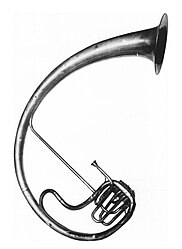 | |
| Brass instrument | |
|---|---|
| Classification | |
| Playing range | |
 Written range | |
| Related instruments | |
|
Saxhorn, Saxotromba Trumpet, Bugle Tuba, Wagner tuba Cornu, Buccina, Roman tuba | |
The saxtuba is an obsolete valved brass wind instrument conceived by the Belgian instrument-maker Adolphe Sax around 1845.[1] The design of the instrument was inspired by the ancient Roman cornu and tuba. The saxtubas, which comprised a family of half-tube and whole-tube instruments of varying pitches, were first employed in Fromental Halévy's opera Le Juif errant (The Wandering Jew) in 1852. Their only other public appearance of note was at a military ceremony on the Champ de Mars in Paris in the same year. The term "saxtuba" may also refer to the bass saxhorn.[2]
- ^ Clifford Bevan (1990) gives the instrument's name as Saxtuba throughout. Other sources refer to the Sax-tuba or saxo-tuba.
- ^ Mitroulia 172; "Definition of SAXTUBA". Merriam-Webster. Retrieved 2023-02-20.